For its objects including Teaching and Field Practice, Experiment Research, Ecological Tending and Demonstration in Forest Management, during the period of planning and management, the Experimental Forand genetic diversity of the forest ecosystem, conserve inherent species and habitats of animals and plants, make sustainable uses of forest resources with local social demands and environmental value and bring the functions of multipurpose forest management into effect to reveal our achievements in demonstration management according to the long-term forest ecological system management concept.
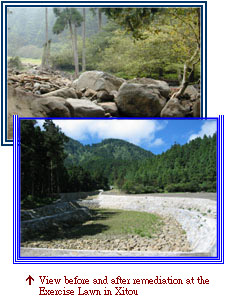
§To make plans
At the time of transformation of forest resources management, the Experimental Forest actively readjusts the manpower and material resources etc. during the organization readjustment of Taiwan Provincial Government, and brings team spirit into effect. At the same time we regard “Ecosystem management” as our main philosophy, focus on the endless development of ecological tending and forest ecosystem and inspect the achievements of the finished management planning; Furthermore, to respond to the incorporated administration in the future, we also make the “Organization Evaluation” of the Experimental Forest, and write “Experimental Forest White Paper” and “Experimental Forest Annals” for public’s understanding of the Experimental Forest, further obtain attention and support from them.
The 8th stage of our 10 Year Project will soon be completed in 2008, and we are not only working on the formulation of the “9th Stage” but also other projects such as “Duigaoyue Camphor Divine Tree Protection” and “Duigaoyue Forestation Measuring and Cleaning up.”
§Mountains management and flood control
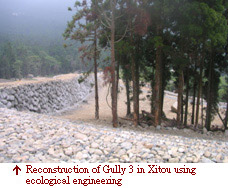
We will investigate the existing landslip lands and the areas with potential landslide in thebudget year after year to manage the landslip lands and avoid further landslip and disasters in accordance with the actual situation.
After the 921 Earthquake, as far as the mountain management and flood control concerned, the Experimental Forest mainly focuses on natural and ecological engineering methods, and use local materials according to the construction methods to maintain the scenes considering the nature ecological system at the surroundings of slopeland and rivers.
§Business informationization
To assort the computerized management policies made by the Executive Yuan, the Experimental Forest actively renews and installs computer software and hardware. As far as the hardware concerned, PCs are used widely. There are various 155 computers available in the Experimental Forest as of the end of 2006, in which 82 in our experimental forest office, and 7 in each tract. Basically each officer has one computer. At present more computers would be added planned. As far as the network concerned, 5 sets of severs are installed with master-slave local area network and area network
 have been established among tracts.
have been established among tracts.Additionally, regarding the software, various ones have be renewed or bought depending on the demands, so that the information can be transmitted among domestic relevant institutes; and since 2000 the geographical information system and the relevant software and hardware have been used to setup management data, further integrate the pictures and word information to assist the forest land management and decision making.
Besides, some system applied to the Experimental Forest will be developed depending on business demands. The documentation and management of the Experimental Forest have been digitized since the end of 2006 in order to achieve better efficiency. The content of our website is also constantly being updated.
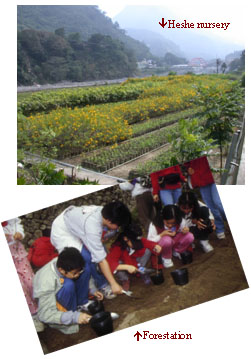 §Forestation
§ForestationForestation still is the basis of forest resources tending and sustained development. The Experimental Forest cultivated hundreds of thousands of seedling trees every year from 1997 for the forest rebuilding after the 921 Earthquake and Typhoon Toraji according to the “Civil Forestation Action Agenda and Implementation Planning”.
The present forestation work is to cultivate a lot of seedling trees for schools, institutes, communities, parks and national forest compartments, besides continuous forestation, forest conservation, nature forest tending and strengthening man-made forests. Not only will the forested area be increased, but also can the harmonious relations of neighborhood be obtained.
§Forest Operation
Forest Operation is important for the forest plantation stage. The seedlings of newly-planted, elimination-planted, and supply-planted forests need to operate well, otherwise the work will fail.
Forest operation includes weeding, cutting tendril, pruning brunches, and inter-cutting, but with differences in stand growing ages the contents of operation will be different. The Experimental Forest not only considers the species of the plantation but also emphasizes the operation of stands and the management of nutrients of forest lands in approaching the goals of amount of mature timber and sustainable management.
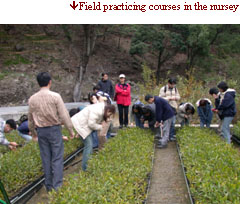
§Management of forest land
In accordance with the Main Points on Forest Management and Forest Management Examination Enforcement Rules, the Experimental Forest will strengthen collective inspection of all tracts to prevent the illegal cutting and improper cultivation. At the same time we will strengthen the countermeasures against forest fire, investigation and report of natural disasters and prevention and cure of forest blights, pests or the damage from other animals etc..
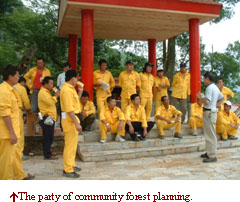
§Community Forest Planning
To popularize the community forest and obtained expected harmonious relations of neighborhood, the Experimental Forest advances “Community Forest-Civilians’ Participation in Forest Tending and Symbiosis Planning”and actively held the relevant seminars from January 2003 to promote the community civilians to participate in the forest conservation planning.
§Forest Recreation
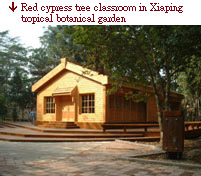
Forest recreation is one objective of multiple purposes of forest management. Based on public’s demands for outdoor space and the deep development popularized by the Taiwan Provincial Government energetically, the Experimental Forest offers some forests for outdoor activity, ecological education and recreation, and popularize the multipurpose management while strengthening the nature education and forest conservation according to the social demands.
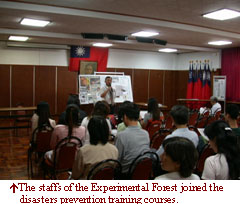 §Disasters Prevention Training
§Disasters Prevention TrainingLarge forest patches are available in the Experimental Forest but some forests are located in remote area. Therefore, the Experimental Forest particularly pays attention to the forest fire prevention and knowledge transmission. At present all staffs has been organized for preventing forest fire, and fire fighting drillings have been conducted.
§Demonstration and popularization of forest utilization techniques
The Experimental Forest established a wood utilization center in Shuili Township, where not only produce desks and chairs for school students but also develop furniture and wooden products for market, besides its function as teaching and practice place for teachers and students.
2.Environmental Conservation:
The main purposes of the nature conservation are to protect and manage nature resources and obtain sustainable utilization of nature resources. At present, in order to conserve various nature resources in the worlds, many countries not only strengthen the concept and measures of ecological conservation besides forest products, cultivation and recreation etc., but also actively select the forest types and ecosystem to establish conservation areas. It is the keystone to realize that forest ecosystem management is the way to reach the ecological principles for our future conservation planning.
With diverse topography, various plants are available in the Experimental Forest. At the same time, the Experimental Forest is a good habitat for animals and an important ring among the conservation area network in Taiwan. Right now we have the “Security Forest” (including the national park within our forest) and the “Duigaoyue camphor Divine Tree Natural Protection Forest” which is located in the Shenmu Village in Nantou County. This place is the 31st compartment of our Duigaoyue Tract, which is located at the elevations between 1,300~2,180 meters, with a total area of 167 hectares. This is a cluster of typical Taiwanese Machilus-castanopsis zone and included the oldest broadleaf tree – the Camphor Divine Tree, providing a great place for recreational and academic purposes. In order to create a more complete preservation area, we are restructuring the site and establishing 10 natural ecological nurturing areas or preservation areas that serve to preserve species and for us to study the configuration, construction, succession, renewing, management, and economic benefits of forests.
There are two categories of plant species under protection in Taiwan, including preserved species and rare species in accordance with the Cultural Property Preservation Law, the Enforcement Rules of Cultural Property Preservation Law, Wild Plants Conservation Strategy and practice definition. However, in consideration of that many other kinds of precious species are available in the Experimental Forest, the “Regulations on the Management of Precious, Preserved and Rare Species in the Experimental Forest” had been promulgated. In addition, those precious species are protected by active conservation.
Conservation Areas Projected by the Experimental Forest in Accordance with Habitat Nature Component, Conservation Objects or Purposes
|
Name |
Position |
Area(ha) |
Altitude(meter) |
|
|
Heshe 32nd ~42nd |
6,031 |
1,200~3,952 |
|
Aiyuzi Broadleaf |
Duigaoyue 29th |
129 |
1,500~2,100 |
|
Shenmu Broadleaf |
Duigaoyue 31st |
181.35 |
1,300~2,200 |
|
Yushan Alpine Ecosystem Conservation Area |
Heshe 34th-38th |
*** |
More than 3,000 |
|
Batongguan Alpine Grassland Ecosystem Conservation Area |
Heshe 41st, 42nd |
*** |
2,500~3,300 |
|
|
Heshe 39th |
*** |
1,200~2,000 |
|
Xitou, Fenghuang Broadleaf Ecological Conservation Area |
Xitou 3rd, 6th Forest Compartment and Neimaopu 21st |
365 |
1,400~1,600 |
|
Tataja Picea Conservation Area |
Heshe 33rd, 34th |
340 |
2,000~2,600 |
|
Dongpu Taxaceae Conservation Area |
Heshe 33rd, 34th |
*** |
2,500~2,800 |
|
Luona Parent Taiwania cryptomerioides Conservation Area |
Heshe 25th |
About 100 |
1,300~1,500 |
|
Niuchou Valley Zelkova serrata Conservation Area |
Neimaopu 23rd, 24th |
About 28 |
850~1,100 |
|
Fongguiedou Quercus variabilis Conservation Area |
Neimaopu 23rd Forest Compartment |
About 3.4 |
750~900 |